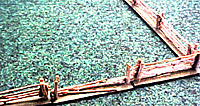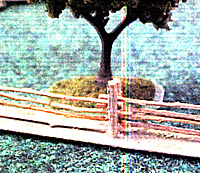 There are two kinds of post and rail fences. The
easier ones to build with twigs are the kind that have
two posts side by side with just enough space to lay
the ends of rails between them. The photo on the back
of the Johnny Reb II rules box shows an example of
the two-post fence.
There are two kinds of post and rail fences. The
easier ones to build with twigs are the kind that have
two posts side by side with just enough space to lay
the ends of rails between them. The photo on the back
of the Johnny Reb II rules box shows an example of
the two-post fence.
On a piece of cardboard 1/2" wide and as long as you want your fence section to be, set up pairs of posts at intervals equal to the length of the fence rails. Lay the first row of rails in every other gap between the posts. Add a second row of rails in the alternate gaps, with each end resting on the end of a rail in the first row. Continue until your fence is the desired height.
If the posts pull apart, wait awhile for the glue to dry before laying the rails. Or, bind them together with a very thin wire that in scale will look like baling wire. You can still see some real fences today where the two posts are held together by this method.
 The ends of the fences again present a problem.
Add a very short piece of twig between the rails at the
ends of the section to keep them even.
The ends of the fences again present a problem.
Add a very short piece of twig between the rails at the
ends of the section to keep them even.
I have yet to find a good way of using twigs to build the other kind of post and rail fence, in which there are (usually) four holes bored through the post, with the rails tapered on the ends and laid into the holes. Around Gettysburg there are thousands of these fences. I have simulated this kind of fence by whittling the posts flat on both sides, then gluing the flattened ends of the rails directly to the posts. However, this method is time-consuming and does not look convincing to me.
As a final touch, make some demolished fences of the same type as your whole ones. Insert these in places where a column has stormed through. They are much more aesthetically pleasing than cardboard markers indicating "gap in fence".
Scratchbuilding Fences and Stone Walls
Back to Table of Contents -- Charge! # 3
Back to Charge! List of Issues
Back to MagWeb Master Magazine List
© Copyright 2004 by Scott Mingus.
This article appears in MagWeb.com (Magazine Web) on the Internet World Wide Web.
Other articles from military history and related magazines are available at http://www.magweb.com